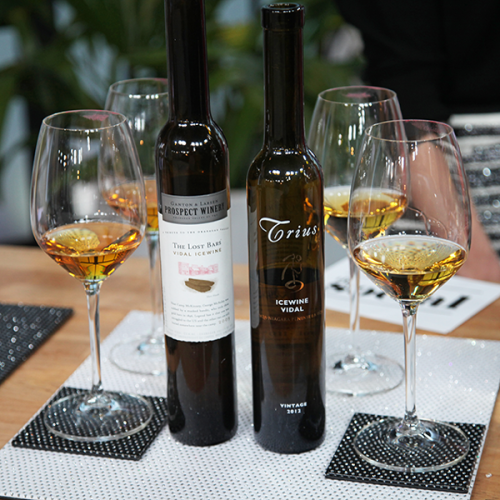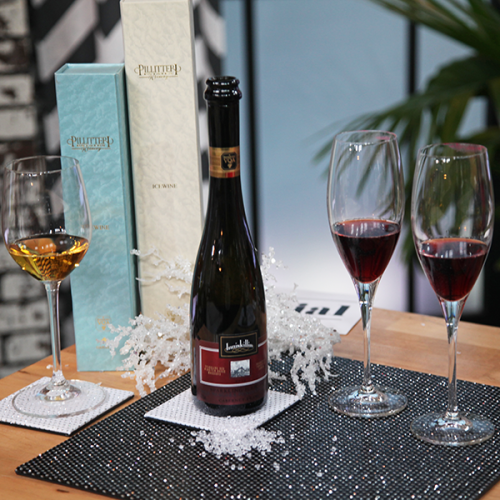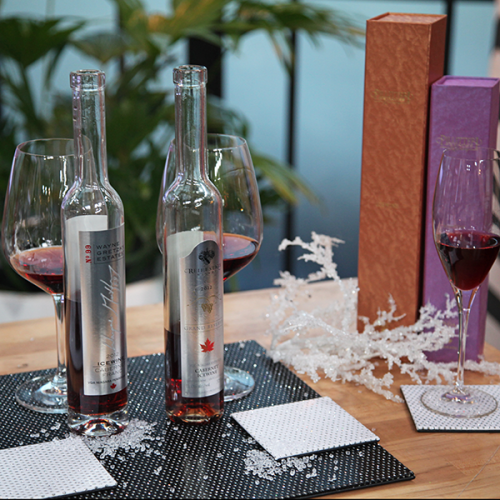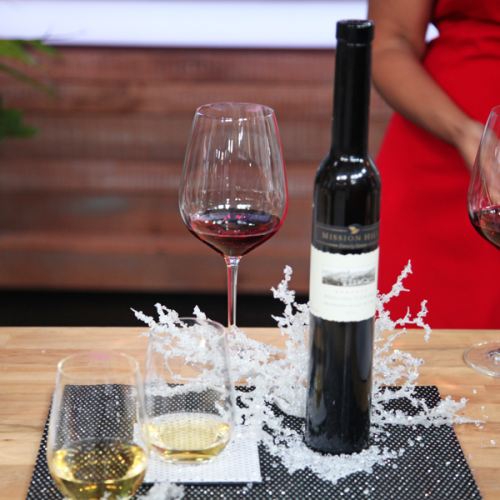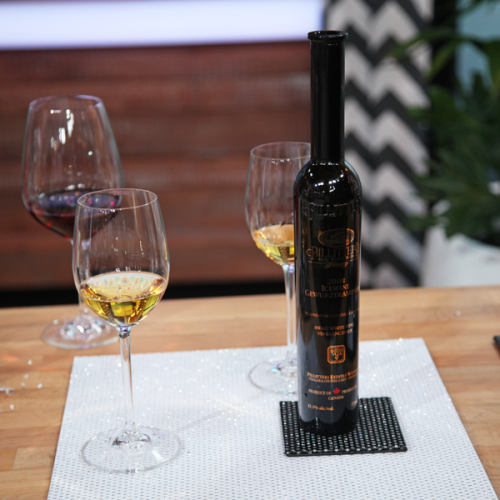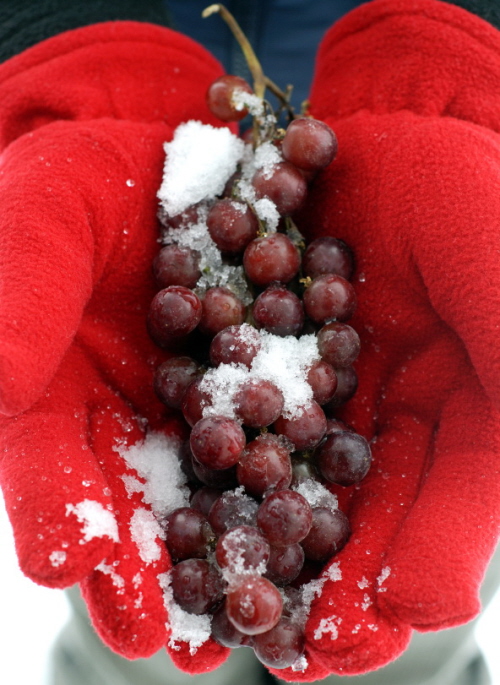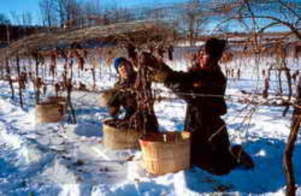Icewine: Canada’s golden winter elixir … that’s the hot topic of our segment above on CTV’s The Social.
What is icewine and how is it different from other sweet wines? Why is Canada the world leader in producing it?
Which are the best Icewines to buy right now and which food pairs best with Icewine?
You’ll find all of the icewines we discussed in this segment, along with dry red and white wines, showing you the stock for each wine at your closest liquor stores so that you can try them this weekend.
Where was Icewine first made?
Icewine is believed to have been accidentally discovered in Germany in 1794 when farmers tried to save their grape harvest after a sudden frost.
Icewine first appeared on the Canadian landscape in 1973, resulting in the first commercial release by Hainle Vineyards from the Okanagan.
There are now 96 wineries that produce Icewine in Canada: NS (3), BC (20), ON (71) and QC (2) of more than 500 wineries in Canada. The 23 producers in Quebec label their product Icewine but they harvest prior to -8C and hang in nets.
Ontario exports 81% of Canadian icewine, BC 16%, Quebec 2% and Nova Scotia 1%.
Why is Icewine so expensive?
Most harvests usually occur in January, but that can mean a crop loss of as much as 60 percent compared to the fall harvest due to predators such as starlings, deer, insects, as well as weather: rain and hail storms that can blow the grapes off the vines, dropping them to the ground, where they can’t be used. Netting the vines helps reduce some of the losses.
Each week past mid-January that picking is delayed because it’s not yet cold enough can mean another 10 percent loss of the crop. In 1997, with El Nino warm temperatures, Ontario (all Canadian?) vintners lost 75% of their icewine grapes.
It takes about 3-4 kilograms (8 pounds) of grapes to produce one half bottle of icewine, whereas that same amount of grapes would make six to seven times as much dry wine.
What is the most expensive Icewine ever sold?
The most expensive icewine ever sold was Royal DeMaria 2006 Chardonnay Icewine, sold to a Saudi prince who paid $30,000 for a half bottle. The winery now lists the award-winning 2000 Chardonnay Icewine for a cool $250,000 a bottle.
Canada was recognized in international competition for its icewine when Niagara’s Inniskillin Estates won the coveted Grand Prix d’Honneur in 1991 at Bordeaux’s VinExpo.
Where does Canada stand in the world in Icewine production?
At the very top. Our winters are consistently cold enough to make icewine every year, whereas Germany and Austria do not.
Canada is the largest icewine producer in the world, last year 2.5 million bottles worth $70 million retail. People relate to Canada as a top Icewine producer due to our extreme Canadian winters. It makes sense to them that we would make it. Canada’s top international awards are dominated by Icewine.
US President Obama served the 2003 Inniskillin Gold Oak Aged Vidal Icewine served at his Nobel Peace Prize Dinner in Oslo, Norway.
How did this year’s Icewine harvest go?
Join me on our Sunday Sipper Club at 6 pm eastern as we’ll be chatting about this year’s Icewine harvest with special guest Dan Speck from Henry of Pelham winery.
Was this a good vintage for Icewine?
What were the challenges in making it this year?
What should we look for when buying Icewine (insider tips)?
How is icewine different from other sweet wines?
Icewine is different from other sweet wines: It’s a matter of cold versus rot. Sweet wines, such as French Sauternes and Barsac, Hungarian tokay and some late harvest wines, depend on botrytis cinerea, or “noble rot.” This fungus penetrates the grape skins and allows the water to evaporate, concentrating the juice. However, with icewine, the water in the grapes freezes more quickly than the sugar and separates out, concentrating the sweetness and fresh fruit flavours of the dehydrated grapes.
The grapes for icewine are picked and pressed at -8oC or colder. That’s why grapes are typically picked at night so that the concentrated winter nectar isn’t diluted by melting. If that does happen, the wine must be labeled as “late harvest” rather than icewine. The thermometer may read -10oC or so, but the wind chill makes the night feel more like -30C.
Producers pick their Cabernet Franc and Riesling first due to the thinner skin. The hearty, thick-skinned Vidal can hang longer.
Does it ever get too cold?
Yes. At -14oC, however, the grapes yield too little juice, and that miniscule amount is so sweet that the yeast can barely survive to start fermentation. One year, Inniskillin started pressing at midnight—and didn’t see a dribble of juice until 8 a.m. During the night, the vinous pellets broke two wine presses. The yield of juice for icewine is only 10-15 percent of unfrozen grapes.
The frozen grapes are rushed back to the winery where the doors are left wide open so that no melting occurs. The vintners work from eight to twenty-four hours in this sub-zero environment pressing the grapes, a grueling process that requires the extreme pressure just to extract syrupy juice from unyielding grape pellets.
The pressure to press frozen grapes can be up to 210 pounds per square inch as compared to just 20 for regular, unfrozen grapes. They are pressed in purpose-built presses for icewine. The water is left in the press as ice crystals.
Why not just freeze the grapes in the fall?
One wonders if it wouldn’t be easier to skip the keen cold while the grapes are wheeled into a big freezer back in the fall? Some producers do take that tack in California, Australia and other regions where the temperatures don’t get cold enough to freeze grapes naturally. These places make an ersatz version of icewine they call “icebox wine” However, these “freezer wines” lack the intensity and complexity of the real thing. Freezer-frozen grapes haven’t hung on the vines as long, undergoing the physical and chemical changes that give real icewines their unique aromas and flavors.
Why is Icewine fermentation also difficult?
Fermentation is much harder to complete as juice is so high in sugar which in turn makes the viscosity greater and that stresses the yeast (we all know what stress can do to us). The yeast has more sugar to convert to alcohol: it’s working over-time and not happy about it.
All winemaking processes are slower and harder to complete because of the sweetness of the juice. Higher sugar concentration causes higher osmotic pressure for the yeast, the result is a slower fermentation.
The yeast has a difficult time surviving in that high viscosity or high sugar juice which is why many producers add a much higher yeast population to begin with.
Why is China, not the US, Canada’s highest export market for Icewine?
There are many theories, among them that our closeness to the US makes us and our products less exotic to Americans. The distance and the unknown aspect of a winter harvest makes our harvest and icewine more mysterious for the Chinese.
Further, the Chinese are more interested in the taste profile of the concentrated, rich icewine wines than Americans, and are willing to pay for it. They are impressed with the international awards and the prestige that accompanies Icewine and they have a much stronger gifting culture.
Is Icewine trademarked?
VQA Canada has the trademark rights for Icewine in Canada, and the federal legal definition is “made from grapes naturally frozen on the vine.” Provincial regulations in Ontario, British Columbia and Nova Scotia also define icewine as “naturally frozen on the vine.”
Canada has secured agreements internationally to protect its interests in icewine including the name and definition.
Due to the high incidence of counterfeit and imitation ice wine products, in particular in China, market development activities are closely linked with efforts which will target the existence of counterfeit products and work towards identifying ways to educate trade and consumers on imitation ice wine.
US is also an important market with key cities identified as a priority markets in the US in terms of trade promotion and export market development. For Ontario, New York has been identified as a priority market due to its proximity and the fact that it is receptive to imported wine, home to influential writers and trade, and is a city with a well-developed wine and food culture.
For British Columbia, the focus is on Seattle, Portland and San Francisco, due to close geographic proximity to the region and the focus on developing wine tourism links between British Columbia and the US Pacific Northwest.
Counterfeit Icewines have become prominent items in retail stores across Asia bearing false labels which include:
• Maple Leaf
• Canadian Flag
• Fake winery logos
• Canadian geographical names
Some estimate that as much as 50% of icewine sold in China is fake.
Most unusual place your Icewine has been consumed?
In the hot desert of the Baja Peninsula – I like the irony of enjoying a wine made in extreme cold being consumed in extreme heat.
– Inniskillin winemaker Bruce Nicholson
Inniskillin Niagara Estate Sparkling Cabernet Franc Icewine Niagara Peninsula, Ontario V.Q.A., Canada A cranberry-rich sparkling red Icewine from the iconic producer Inniskillin. Made from Cabernet Franc grapes. Aromas of black cherry on the finish. Perfect for Black Forest Cake.
Reif Estate Winery Vidal Icewine Niagara River, Ontario V.Q.A., Canada Gorgeous apricot preserves in this lovely Niagara Icewine from Reif. Luscious layers of peach preserves fold over each other across your mouth and then bring on a tide of pleasurable sun-dappled orchard fruit on the finish. Pair with fruit flans and cobblers.
Reif Estate Winery Grand Cabernet Franc Icewine 2012 Niagara, Ontario, Canada Homemade strawberry jam in a glass: this icewine is opulent and comforting at the same time. Raspberry, strawberry and rhubarb aromas and flavours flood the senses. Perfect with dark chocolate truffles.
Wayne Gretzky Estates No.99 Cabernet Franc Icewine Niagara Peninsula, Ontario V.Q.A., Canada Aromas of fresh strawberry and raspberry wrap themselves around your senses in this dazzling Icewine. A superb effort.
![]()
Mission Hill Family Estate Reserve Riesling Icewine 2011 Okanagan BC V.Q.A., British Columbia, Canada This lovely icewine hails from the challenging 2011 vintage. It’s a tribute to Mission Hill’s winemaker that this dessert wine still displays its classic signature in all it’s apricot-peach glory with perfect balance.
Trius Winery at Hillebrand Vidal Icewine 2012 Niagara, Ontario A stunningly rich and satisfying icewine with notes of peach, pear and apricot preserves. Perfect with a fruit flan or cobbler.
Ganton & Larsen Prospect Winery The Lost Bar Vidal Icewine 2009 Okanagan Valley, BC, Canada Lovely richness and tropical fruit decadence in this icewine. A great dessert on its own or with biscotti or angel food cake.
Peller Estates Oak Aged Vidal Icewine Niagara Peninsula, Ontario V.Q.A. Superb richness and layers in this icewines from the oak aging. It’s like wrapping apricot in vanilla spice. The luscious mouth-filling intensity.
Mission Hill Family Estate Reserve Riesling Icewine 2011 Okanagan British Columbia BC V.Q.A., This lovely icewine hails from the challenging 2011 vintage. It’s a tribute to Mission Hill’s winemaker that this dessert wine still displays its classic signature.
Pillitteri Estates Winery Gewurztraminer Icewine 2008 Niagara-on-the-Lake, Ontario Generous aromas and flavours of apricot, peach, mango, and clementine in this superb icewine.
Wayne Gretzky Estates No.99 Cabernet Franc Icewine Niagara, Ontario Aromas of fresh strawberry and raspberry wrap themselves around your senses in this dazzling icewine. A superb effort.
Reif Estate Winery Grand Cabernet Franc Icewine 2012 Niagara, Ontario Homemade strawberry jam in a glass: this icewine is opulent and comforting at the same time. Raspberry, strawberry and rhubarb aromas and flavours flood the senses. Perfect with.
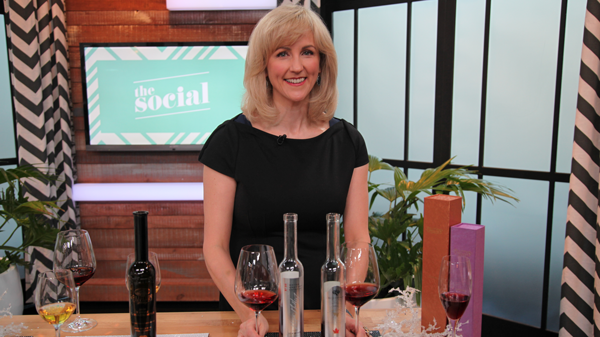 Posted with permission of CTV.
Posted with permission of CTV.
Icewine: Canada’s Gold in a Glass
Traci: Welcome back! Yes it’s cold and miserable out but I guarantee this will warm you up. Its prime ice wine season.
Cynthia: Like many people I’m intrigued because well wine is part of the name.
Traci: Yes.
Cynthia: I really don’t know very much about them at all, so here to enlighten us is wine writer and sommelier Natalie MacLean. Thanks for being here.
Traci: Happy New Year!
Natalie: Glad to be here. You too.
Cynthia: Natalie, I have to start with the obvious question … What, exactly, is ice wine?
Natalie: Ice wine is a dessert wine. We are specialists in making it in Canada. The key to making ice wine is that the grapes are naturally frozen on the vine. In December or January, they must be picked at -8˚ often overnight at midnight.
Traci: It sounds like a mystery novel.
Cynthia: It does.
Natalie: It does! It’s very concentrated it’s a sublime exotic winter elixir. It takes so many grapes just to make one of these little half bottles. They say 1700 grapes must be grown because they lose so much to the winter frost.
Traci: My gosh. That’s a lot.
Cynthia: This year I imagine would be really good. We’ve had such freezing conditions?
Natalie: Good point.
Traci: And flash freezing?
Natalie: Absolutely! Very good, nice term … very technical.
Traci: I know my wines. I know a little bit of a wine.
Natalie: Absolutely. An early frost and a cold weather means they get those grapes to the winery earlier so the starlings, who just love ice wine grapes, have less chance to have at ‘em. The winter of course means hail, dropping the grapes and ruining them. We’re going to have big harvest this year and a really good one.
Traci: Well that’s great!
Cynthia: Great.
Traci: A good harvest means good wines and let’s have a little bit of an ice wine tasting.
Natalie: Yes.
Traci: I know, it’s good times. We’re going to start with the Sparkling ice wine.
Natalie: Right.
Traci: So why are we starting over here?
Natalie: We’re going to start with Sparkling because we always want to up the amps, sensory wise. We want to go from the least sweet to the sweetest.
Traci & Cynthia: Least sweet…
Traci: To the most…
Cynthia: This is like the Lainey of wine and we’re going to the Melissa.
Traci: To the Melissa.
Natalie: Exactly! Perfect!
Cynthia: Right.
Traci: And we’re somewhere in the middle.
Cynthia: That’s right, good.
Natalie: Take a taste of this.
Cynthia: Okay.
Traci: Okay.
Natalie: It’s a combination.
Traci: If you insist.
Natalie: You have to do your research.
Cynthia: Okay.
Traci: It’s nice.
Cynthia: I didn’t even know that ice wines came in red, to be honest.
Natalie: They do. This is experimental in the Niagara and the Okanagan regions. They’re trying all kinds of grape. Are you liking it?
Traci: Absolutely.
Natalie: Yes?
Traci: It tastes sweet.
Cynthia: It’s a taste of berries.
Natalie: It does.
Cynthia: And very sweet.
Natalie: That’s the red grape flavour coming through, yes!
Traci: Like it is really coming through the grape.
Cynthia: Do you have to have these as a dessert wine like with desserts? Are you going to eat a cake with this?
Natalie: No, well you can if you want.
Cynthia: Okay.
Natalie: Sparkling wine, in particular, is less sweet so you could pair it with cheeses and nuts, biscotti and less sweet desserts. Have it on its own … it’s a dessert in a glass.
Traci: This is really good.
Cynthia: It is beautiful.
Traci: Delicious!
Cynthia: And that’s a Vidal wine so this is a little bit more affordable, right?
Natalie: Yes, as are these, we’re going to go to a still Vidal grapes.
Cynthia: Okay.
Natalie: And we’re going to have a showdown east to west.
Traci: And what is a Vidal grape?
Natalie: Vidal is a tough skin hardy little grape.
Traci: A snappy grape.
Natalie: It is. It can deal with Canadian winters.
Traci: Alright.
Natalie: It’s our kind of grape and so that’s why it’s often the most popular and affordable. They don’t lose as many grapes as your other more delicate grapes that are high maintenance. Here give this a try.
Cynthia: It’s our East – West showdown.
Natalie: It is.
Traci: Let’s drink.
Natalie: You can even see a colour difference here so which …
Traci: Can I try one the same as you? What’s this one?
Natalie: We have B.C on that side there we you go.
Cynthia: Okay.
Traci: That’s it?
Cynthia: Yes.
Natalie: Prospect Winery in B.C and well you tell me what do you get from that? Are you getting… tropical fruit?
Cynthia: It’s still there… Yes, mango!
Traci: Mango.
Natalie: Yes.
Cynthia: Mango is the dominant one.
Natalie: Exactly.
Traci: Yes.
Natalie: Pineapple-mango?
Traci: Pineapple.
Cynthia: Papaya.
Natalie: You’re getting just to the fruit.
Traci: I’m just going to throw out tropical fruit.
Cynthia: Okay.
Natalie: Excellent! So and you’ll notice a very deep rich colour. The concentration is viscous. Its like a mouth coating incoming…
Traci: I can listen to you all day.
Cynthia: Thank you.
Natalie: Good excellent! Okay, let’s try the Niagara one from Trius.
Cynthia: Thank you.
Natalie: And we get a bit layer here … I think you’re still going to get some tree fruit, maybe lighter melon notes.
Cynthia: Melon, when you say it, it hits me.
Traci: It does, it is a little heavier.
Cynthia: A little power of suggestion.
Traci: This one’s a little bit heavier, a little thicker.
Cynthia: Yes.
Natalie: Right.
Traci: Didn’t President Obama have one of these?
Natalie: He did. He had the Vidal oak aged so it would be even more robust. It was from Inniskillin and he served it at his Noble Peace Prize dinner in Oslo.
Cynthia: It’s good enough for Obama.
Traci: Well you know what you don’t have to be upset because he’s Prize winner.
Natalie: Exactly.
Traci: It’s good.
Cynthia: We’re going to move on to a Riesling.
Traci: More Riesling.
Cynthia: So Riesling grape.
Natalie: Riesling, so this is a bit more finicky grape. It also makes a dry wine like most of these other grapes do. We lose more to the predators and the weather. You’re getting up into the $55 to $60 range now.
Traci: The birds make the ice wine expensive?
Natalie: They do.
Cynthia: Wow!
Natalie: They’re horrendous birds. Starlings are not even native to North America. Some romantic fool brought them over to Central Park because he wanted to populate it with all the sunbirds in Shakespeare’s sonnets.
Cynthia: And now they’re impacting our wine.
Natalie: Yes, now.
Cynthia: For goodness sake.
Natalie: So anyway all for the love of poetry…
Traci: I like the though “Starling”.
Cynthia: Yes.
Natalie: Yes, starlings.
Traci: Back to wine…
Natalie: For the Riesling, I’m going to pour this and you’re going to notice that in all of our glasses we have generous pours of ice wine. A little goes a long way … 2 or 3 ounces … dessert wine like dessert, you don’t need a full chocolate cake.
Cynthia: Well, you don’t. Speak for yourself, Natalie.
Traci: You don’t.
Cynthia: You don’t.
Traci: I like these glasses; I like to drink my wine from rocks glasses or glasses like these.
Cynthia: Yes.
Natalie: These are very fashionable. All of these glasses are made by Riedel. It’s one of several brands. They are very reputable; People either love or don’t love them …
Traci: Don’t.
Natalie: … so much.
Traci: A lot of people wanted to grab their wine glasses by the stem.
Cynthia: I’m already drinking, just so you know.
Traci: Okay, sorry.
Cynthia: Cheers!
Traci: Cheers!
Natalie: Research is thorough. In this one think lemonade … lemons and the sugar together combined. They are more complex than if you just had the sweetness, right? So Riesling has more acidity…
Cynthia: Yes.
Natalie: It balances that sweetness.
Cynthia: It’s not quite as sweet as that.
Natalie: Right, it doesn’t come on.
Traci: Or thick?
Natalie: Exactly.
Traci: But it’s still good, they’re all great.
Natalie: Right, so again fruit flams.
Traci: It’s 5 o’clock somewhere.
Cynthia: More is more.
Traci: This, honestly, is one of my favourite ones…
Natalie: Okay.
Traci: I’m probably saying it wrong – Gewurztraminer.
Natalie: Wow!
Cynthia: Bless you!
Traci: Yes?
Natalie: Gewurztraminer.
Traci: I really, truly enjoy an ice wine Gewurztraminer now, sorry.
Natalie: They’re good.
Traci: It was the last two that I drink. So tell me about this, what makes this one special?
Natalie: So Gewurzt transalates…
Traci: Is it? It’s Gewurtsz (gee-vurtz).
Cynthia: Gewurztraminer.
Traci: Gewürztraminer.
Cynthia: Okay.
Natalie: We can just cough. Gewurtz translates to spice and so it means spiced wine. When it’s a dry wine, we often have it with Asian curries and spicy dishes with a bit of heat. Give it a try. You’re going to get those spicy notes but with sweetness. sImagine ginger cookies or cinnamon dusted desserts.
Traci: That’s why I like him; it’s a ginger kind of smell.
Cynthia: This is my favourite one.
Natalie: Yes, so you’re getting those Asian spices.
Cynthia: Now this is more expensive though, isn’t it?
Natalie: It is, We’re talking about a finicky grape, a very specialist kind of wine.
Cynthia: Finicky grape. How much is the bottle?
Natalie: So we’re up into $60 – $65 range.
Cynthia & Traci: Okay.
Natalie: Pillitteri one of the largest producers in Canada, experiments with so many grape varieties.
Cynthia: Okay and this is…
Traci: And we have the Cab.
Cynthia: We’ll just do really quickly.
Natalie: Okay.
Traci: Those giant glasses?
Cynthia: They’re there.
Natalie: We have a showdown, yes.
Traci: It’s like this?
Cynthia: So it’s now, we’ll take a…
Natalie: Yes, absolutely. Have fun!
Cynthia: Here we go.
Natalie: Wayne Gretzky!
Traci: Wayne Gretzky, the great one.
Natalie: Yes, the grape one.
Cynthia: Yes, the grape one.
Traci: The grape one, sorry. It’s nice.
Natalie: Well, that’s bad.
Traci: She scores.
Natalie: Almost. So he’s not the winemaker obviously but he’s got his name on the label. It’s a great Cabernet Franc … hardest grapes of all, red grapes to get them to go to December, January.
Cynthia: Okay, let’s do the showdown with this one.
Natalie: Yes.
Cynthia: I’m going to do it.
Natalie: This is Reif.
Cynthia: We’ll just double.
Traci: Double fizz?
Cynthia: Double fizz.
Traci: Really?
Natalie: Very lovely wine.
Cynthia: Because really this is what you do, right?
Traci: This is Wayne’s 99?
Cynthia: Yes. Wayne’s I did – I liked it.
Natalie: Okay and you should be getting strawberry notes, raspberry you could pair this up with truffles.
Traci: Yes.
Cynthia: The grape one might be the winner of this one.
Natalie: The grape one, yes.
Traci: Amazing.
Natalie: Okay.
Cynthia: You just taste that and you pick a winner.
Natalie: Showdown.
Traci: I’m going to go with the grape one.
Cynthia: Amazing.
Natalie: The grape one. Wow, cheers!
Cynthia: Natalie. You’re always a winner in our book.
Traci: Yes. Thank you. Happy, Happy New Year!
Cynthia: Thank you so much for being here.
Natalie: Thank you so much.
Posted with permission of CTV.


